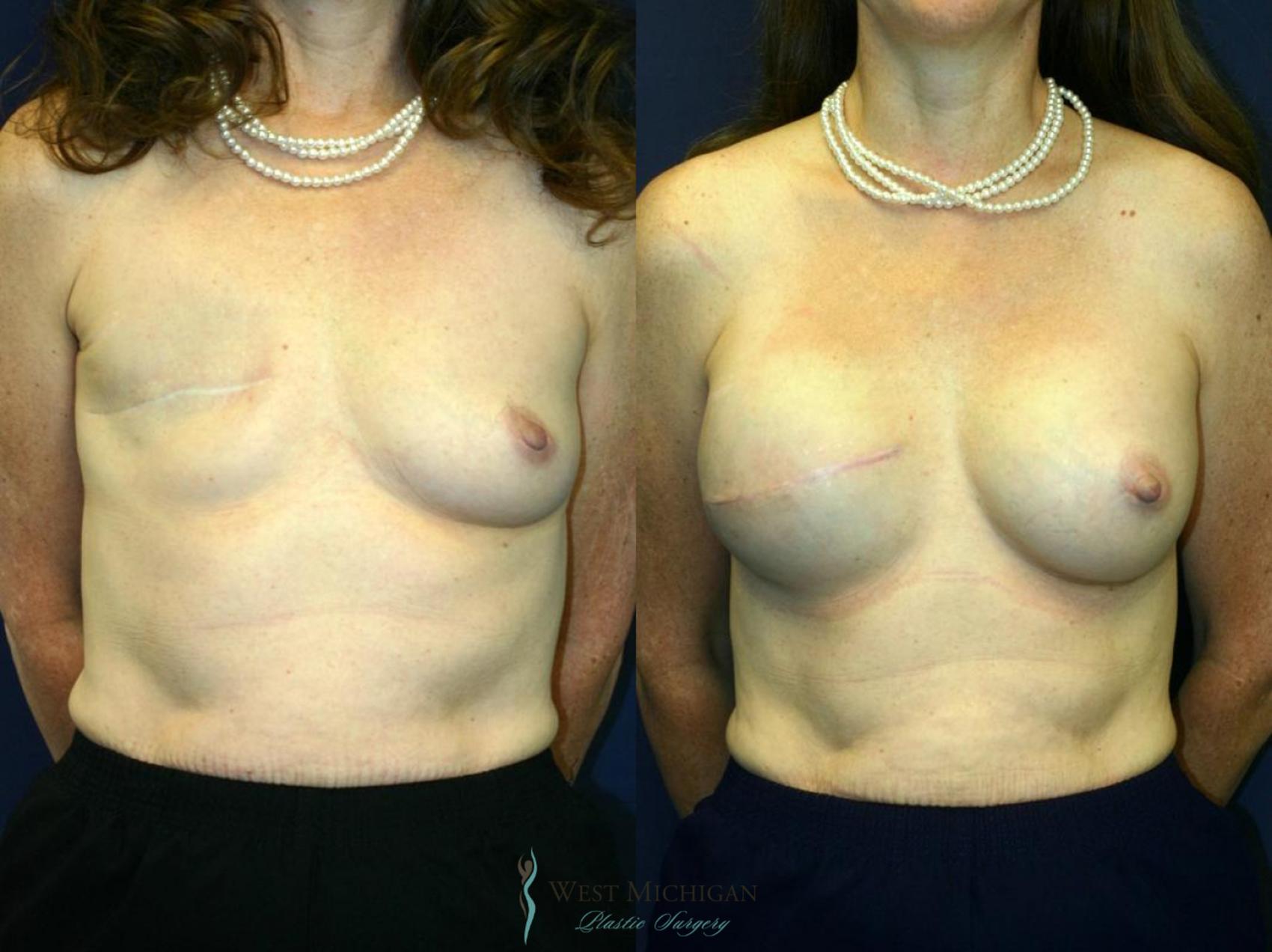West Michigan Plastic Surgery
8175 Creekside Drive, Suite 100
Portage, MI 49024
Phone: (269) 222-1611
Monday–Thursday: 8 a.m.–5 p.m.
Friday: 8 a.m.–4 p.m.
West Michigan Plastic Surgery
3035 Capital Ave SW, Suite 110
Battle Creek, MI 49015
Phone: (269) 222-1611
Tuesday: 8 a.m.–5 p.m.
Friday: 12:30 p.m.–4 p.m.
It’s normal to feel scared and confused if you have to undergo a mastectomy for breast cancer treatment, but breast reconstruction can help with healing and make you feel complete again. At West Michigan Plastic Surgery, Kalamazoo, we understand that breast reconstruction helps women on the road to recovery because it restores their sense of wholeness.
Dr. Scott Holley is trained in both cosmetic and reconstructive surgery, so he has the expertise needed to deliver aesthetically beautiful reconstructive outcomes. Dr. Holley works closely with each patient to create a treatment plan that will best meet their specific needs.
Breast Reconstruction
Before & After Photos
WARNING:
This feature contains nudity. Please click OK to confirm you are at least 18 years of age and are not offended by such material.
What Is Breast Reconstruction?
Breast reconstruction or reconstructive mammaplasty is a surgical procedure that is done to restore the shape and appearance of the breasts after a mastectomy, or even lumpectomy. Reconstructive mammaplasty rebuilds the breast, nipple, and areola, and involves a series of procedures performed in stages.
Breast reconstruction may begin at the time of mastectomy (immediate reconstruction), or it may be delayed for several months or years (delayed reconstruction). Reconstructive mammaplasty can be performed using a variety of different techniques, and the choice will depend on what’s right for each patient’s situation.
Candidates for Breast Reconstruction
Most patients that have undergone a mastectomy are good candidates for immediate reconstructive mammaplasty. Patients who present with more advanced stage cancer, however, may be more suited for delayed reconstruction. Dr Holley will consult with your breast oncologist to gather all pertinent information and provide counseling regarding the most appropriate timing and type of reconstruction for your specific case.
How Does It Work?
Implant reconstruction and flap reconstruction are the two major types of breast reconstruction.
Implant Reconstruction
Breast reconstruction with implants is the most common option for rebuilding the breasts. It involves using a breast implant to restore the natural shape and volume of the breasts.
With implant breast reconstruction, a balloon expander is inserted below the skin and chest muscle after mastectomy. The expander is gradually inflated over the following months by injecting it with a saltwater solution. This allows the mastectomy wound and remaining tissue to stretch to accommodate an anticipated breast implant.
When the tissue has stretched enough, the expander is removed and replaced with the breast implant. In some cases, fat grafting may be discussed and recommended to improve the softness and appearance of the reconstructed breast. A subsequent operation is done to rebuild the nipple and areola, typically 1-2 months following breast mound reconstruction.
Flap Reconstruction
Flap reconstruction uses tissue transplanted from another part of your body to rebuild a new breast. Pedicled flap surgery and free flap surgery are surgical options.
- Pedicled flap surgery: The flap used for the Pedicled flap technique is taken from the back or belly and consists of skin, fat, and muscle, with blood supply intact. The tissue is pulled under the skin up to the chest area and attached.
- Free flap surgery: The tissue used for the free flap technique is cut from its blood supply. After the flap is put in position, the tissue is reattached to the blood vessels in the chest area.
Flap reconstruction is a complex, precise procedure and Dr. Holley’s broad surgical training has proven essential in ensuring natural-looking reconstructive results in hundreds of such cases. Each patient presents with unique concerns and needs. During your consultation, Dr. Holley will review the technical details, risks, limitations, and appropriateness of each potential option and how it applies to your specific condition.
Results
The goal of reconstructive breast surgery is to create a natural-appearing breast mound and restore a sense of wholeness for the patient. The reconstructed breast should look balanced and have a proportional shape and size. To achieve this, surgery may also be required on the opposite, non-cancerous breast. It is important to know that insurance will cover all aspects of the reconstruction process.
Recovery
Breast reconstruction surgery often requires a hospital stay, which may range from 1-5 days depending on the specific procedure. Patients may feel tired and sore for up to 2 weeks after surgery, but full recovery takes 4-6 weeks. Strenuous exercise, sexual activity, and overhead lifting should be avoided for 3-6 weeks.
FAQ’s About Breast Reconstruction
Dr. Holley will consider factors such as your age, tissues, health, and anatomy, before making a recommendation. Consultation with you, your breast surgeon, and oncologist will all help determine the most appropriate reconstructive surgical plan.
How can I plan For breast reconstruction surgery?
It’s best to start thinking about reconstructive mammaplasty soon after diagnosis. You may choose to start the reconstruction process at the time of your mastectomy or delay it until a later date. Several factors can determine the right time for breast reconstruction, so it’s important to consult your oncologist and plastic surgeon.
How do I prepare for breast reconstruction?
You may need to have a medical evaluation done, and your doctor may ask you to stop taking some vitamins and medications prior to surgery. Your oncologist will be contacted to discuss the timing of surgery as it relates to other forms of treatment such as chemotherapy and radiation therapy. Your plastic surgeon will provide perioperative guidelines relating to diet and activity.
What types of breast implants are available?
Reconstructive mammaplasty is typically done using saline or silicone breast implants. During your consultation, Dr. Holley will review the options, and make recommendations based on your specific needs.
Are there any risks associated with breast reconstruction?
There are risks associated with both breast reconstruction techniques. Problems normally associated with surgery such as bleeding, bruising, infection, excessive scar tissue, even tissue loss may occur. Because each reconstructive plan is different, Dr. Holley will thoroughly review the specific risks that pertain to your case.


